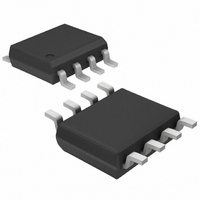MAX3120CSA+T Maxim Integrated Products, MAX3120CSA+T Datasheet - Page 6

MAX3120CSA+T
Manufacturer Part Number
MAX3120CSA+T
Description
IC TXRX INFRARED IRDA 8-SOIC
Manufacturer
Maxim Integrated Products
Type
Transceiverr
Datasheet
1.MAX3120ESA.pdf
(8 pages)
Specifications of MAX3120CSA+T
Number Of Drivers/receivers
1/1
Protocol
Infrared (IRDA)
Voltage - Supply
3 V ~ 5.5 V
Mounting Type
Surface Mount
Package / Case
8-SOIC (3.9mm Width)
Lead Free Status / RoHS Status
Lead free / RoHS Compliant
Low-Profile, 3V, 120µA,
IrDA Infrared Transceiver
The MAX3120’s IR transmitter consists of a high-power
MOS switch, capable of quickly switching 200mA with
less than 2Ω of on-resistance. Internal buffering keeps
the input capacitance of the TXD pin extremely low to
ease the input drive requirement. Connect an IR LED in
series with a current-setting resistor to select the appro-
priate IR output power (see the Powering the IR LED
section). Note that the transmitter does not have an
automatic shutoff circuit, so pay special attention to com-
ponent power dissipation in high-duty-cycle transmit
schemes.
The IrDA specification calls for an IR transmitter with a
peak wavelength between 850nm and 900nm. Within a
±15° half-cone-angle, the output intensity of the IR LED
must be between 40mW/sr and 500mW/sr. Outside a
±30° half-cone-angle, the output intensity of the IR LED
must fall below 40mW/sr. The optical rise and fall times
of the IR LED must be less than 600ns. Based on these
system requirements, the Hewlett Packard HSDL-4220
or the Temic TSHF5400 IR LEDs are two appropriate
choices.
Appropriate PIN photodiode selection is extremely
important to system performance. The PIN diode must
generate at least 200nA (minimum sensitivity of the
MAX3120) of current when aimed ±15° off-axis with an
incident irradiance of 4µW/cm
tion to determine if the Temic BPV22NF meets these
requirements:
Figure 1. Functional Diagram
6
_______________________________________________________________________________________
GND
IR LED and PIN Photodiode Selection
BIAS
RXD
SHDN
Applications Information
V
CC
TXD
BANDPASS
FILTER
MAX3120
2
. Use the following equa-
LEDC
Transmitter
-
+
1.2V
PGND
PINC
The first term (4µW/cm
irradiance in the ±15° angular range. The second term
(0.075cm
diode. The factor of 1.8 accounts for the efficiency
increase due to the spherical lens. The first 0.95 factor
normalizes the sensitivity to the 875nm wavelength,
while the second 0.95 factor adjusts for decreased
receiver efficiency at ±15° off-axis. The last term,
0.6A/W, is the sensitivity of the PIN diode. In this exam-
ple, the Temic BPV22NF is an appropriate selection.
The final important factor in selecting a PIN diode is
effective diode capacitance. It is important to keep this
capacitance below 70pF at 1.2V reverse bias. Higher
input capacitance can compromise system noise per-
formance by increasing the noise gain of the input tran-
simpedance amplifier.
Set the current in the IR LED using an external resistor.
Consult the IR LED manufacturer’s data sheet to select
a forward current that will meet IrDA specifications dis-
cussed in the IR LED and PIN Photodiode Selection
section. Look up the drop across the LED (V
the drop across the MAX3120 LED driver (see Typical
Operating Characteristics - V
rent-setting resistor based on the following equation:
Using the Hewlett Packard HSDL-4220 IR LED as an
example, V
therefore:
I
PIN
(4 W/cm )(0.075cm )(1.8)(0.95) (0.6A/W)
291nA
2
) is the effective sensitive area of the PIN
R
CC
SET
= 5V, I
=
V
2
R
LEDC
V
SET
CC
SET
- V
= 32.5Ω
2
= 0.08V
) is the minimum guaranteed
= 100mA, and V
LED
I
SET
Powering the IR LED
LEDC
2
- V
LEDC
) and choose the cur-
2
LED
LED
= 1.67V,
) and








